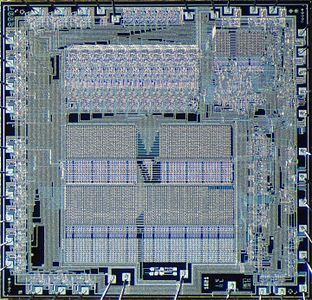MCP-1600
The MCP-1600 is a multi-chip microprocessor made by Western Digital in the late 1970s through the early 1980s.[1][2] Used in the Pascal MicroEngine, the WD16 processor in the Alpha Microsystems AM-100, and the DEC LSI-11 microcomputer, a cost-reduced and compact implementation of the DEC PDP-11.
There are three types of chips in the chip-set:
- CP1611 RALU - Register ALU chip
- CP1621 CON - Control chip
- CP1631 MICROM - Mask-programmed microcode ROM chip (512 – 22 bit words)
The chips use a 3.3MHz four phase clock and four power supply voltages (+5V, +12V, -12V, and -5V), as required by the P-channel enhancement gate process then available at Western Digital. Internally the MCP-1600 was a (relatively fast) 8-bit processor that can be micro-programmed to emulate a 16-bit CPU. Up to four MICROMs are supported, but usually two or three could hold the needed microprogram for a processor.
John Wallace was the Project Manager and designed the 1621, Mike Briner designed the 1611, and later became a Senior VP at Silicon Storage Technology. Bill Pohlman was the design engineering manager and he later was Project Manager for the Intel 8086 processor.
A clone of the CP1611 and CP1621 was manufactured in the Soviet Union under the designation KR581IK1 and KR581IK2 (Russian: КР581ИК1 and КР581ИК2).[3] The Soviet 581 series included other members of the MCP-1600 family as well.[4]
- Die photos from LSI-11 chip set
CP1611 RALU chip
CP1621 Control chip
CP1631 MICROM chip
References[]
- ^ "Western Digital adds MCP-1600 Micro". Computerworld. 26 November 1975.
- ^ "Western Digital 1600". AntiqueTech. Archived from the original on 3 January 2017. Retrieved 5 January 2017.
- ^ "Soviet microprocessors, microcontrollers, FPU chips and their western analogs". CPU-world. Retrieved 2020-04-18.
- ^ Козак, Виктор Романович (24 May 2014). "Номенклатура интегральных микросхем — Микропроцессоры: серии 580 - 589" [Nomenclature of integrated circuits — Microprocessors: Series 580 - 589] (in Russian). Retrieved 24 March 2016.
- 16-bit microprocessors


